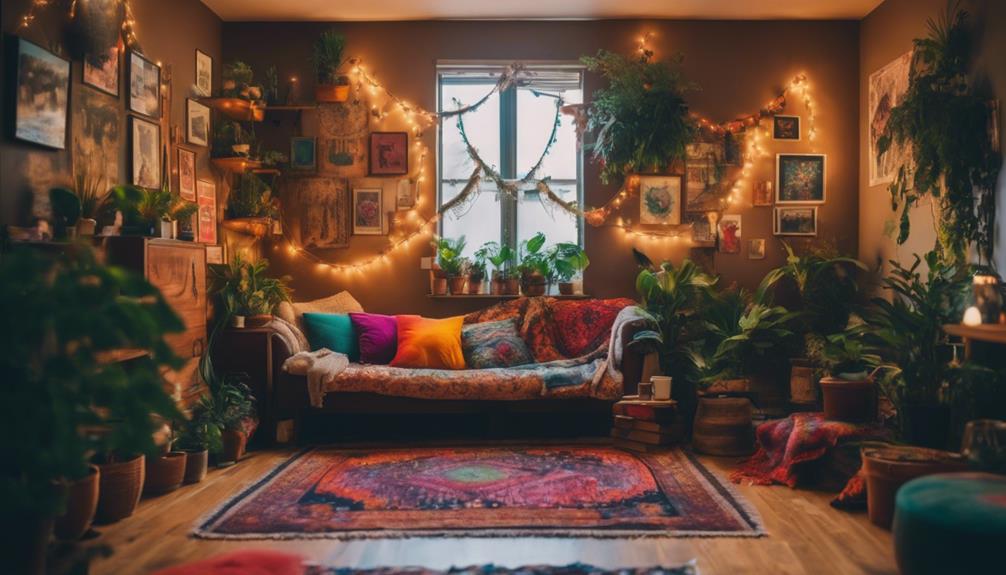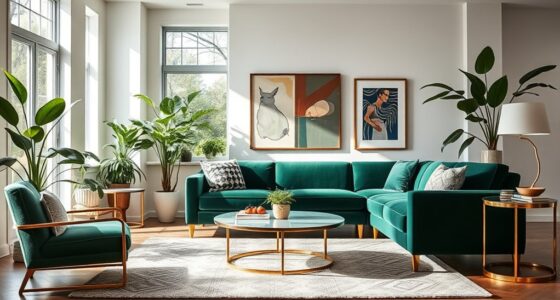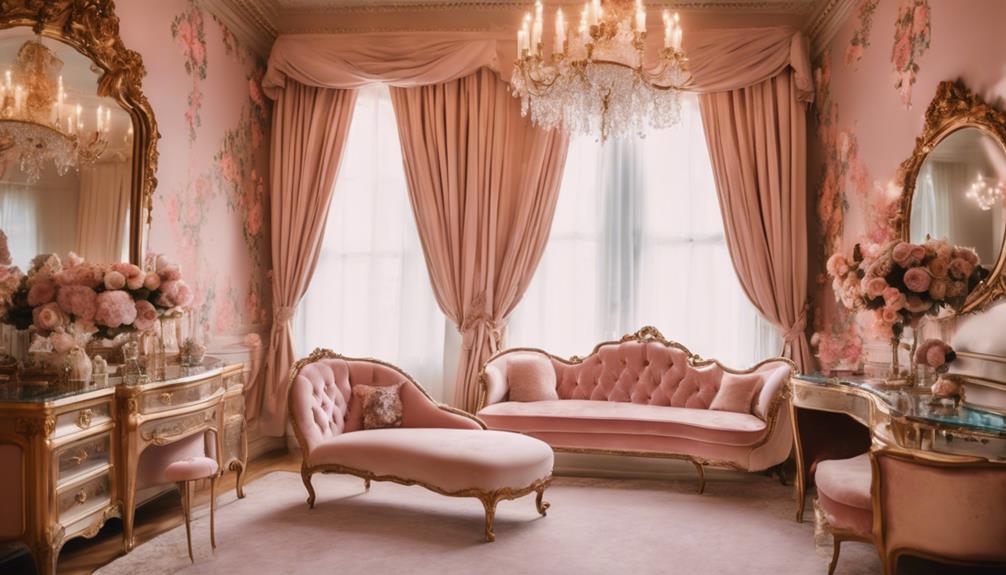You can design a unique indie room that is truly yours by combining bright colors and natural materials. Choose a few vibrant shades, then add layers of textures with retro discoveries like mid-century coffee tables or reclaimed wood bookshelves. Brighten your room with vintage Edison bulbs and playful string lights to create the right atmosphere. Enhance your space with artistic decorations such as macrame hangings and framed album covers for that personal feel. Remember to include a cozy rug or reclaimed flooring for added warmth. By following these suggestions, your space will reflect your unique style and make a statement. Discover more ideas to elevate your aesthetic!
Key Elements
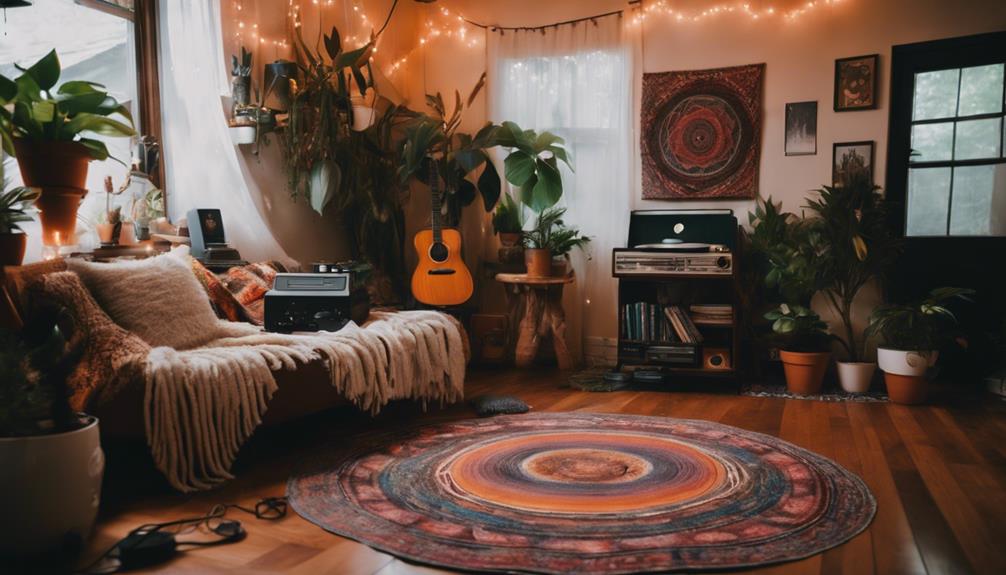
When creating your indie room, focus on the color scheme, materials, and textures to bring your vision to life.
Choosing bold colors and combining various materials will help reflect your unique style.
Don't forget to layer textures to add depth and warmth to your space.
Color Scheme
The indie aesthetic thrives on a vibrant color palette that captures nostalgia and whimsy, making it essential to choose lively hues like pale yellows, greens, and playful oranges. To achieve a unique aesthetic, you'll want to incorporate bright colors inspired by 2000s pop culture, infusing your space with energy and playfulness.
Start by selecting one or two main colors as the foundation of your color scheme. This approach simplifies your design while enhancing visual appeal. Once you establish those base colors, feel free to mix in eclectic patterns and additional shades for a truly personalized touch.
Don't shy away from incorporating earthy tones, as they can balance the vibrancy of your chosen bright colors. Warm browns and soft greens can create a cozy atmosphere, allowing the playful elements to shine without overwhelming the space.
Experimenting with color is key in the indie aesthetic. So, let your creativity flow and have fun with your choices. By blending bright colors and earthy tones, you'll create a harmonious and inviting space that reflects your unique style.
Materials
To enhance the vibrant color scheme of your indie room, focus on incorporating natural materials like wood, jute, and linen for added warmth and texture.
Wood elements, such as reclaimed furniture or shelving, bring a rustic charm, while jute rugs or accents provide an earthy touch. Linen can be used for curtains or throw pillows, offering a soft, inviting feel.
Don't shy away from vintage pieces; these can be sourced from thrift stores or flea markets. A retro lamp or an antique mirror can serve as a unique focal point, adding character and history to your space. When selecting these items, guarantee they complement your chosen color scheme, which should include warm earthy tones and deep jewel tones for a cozy atmosphere.
Incorporating greenery is essential, too. Adding houseplants not only beautifies your room but also purifies the air, creating a calming environment.
Consider hanging plants or small potted varieties to bring life into your indie aesthetic. By thoughtfully combining these natural materials, vintage pieces, and greenery, you'll craft a distinctive space that feels both inviting and stylish.
Textures
Textures are essential in indie room decor, as they add depth and interest by blending various materials like soft fabrics, wood, and metal. To create that cozy, inviting atmosphere characteristic of the indie style, you should incorporate diverse textiles. Think plush cushions, knitted throws, and patterned rugs that invite people to sink in and relax.
Layering different textures is key. You might pair smooth satin with rough jute or soft wool, creating a visually stimulating environment that reflects your personal style. Vintage elements can also enhance your space; consider adding worn leather chairs or distressed wooden tables that not only add character but also tell a story, aligning perfectly with the indie ethos of individuality.
Don't forget about plants! They introduce organic textures and improve air quality, contributing to the warm and lively ambiance essential in indie-inspired spaces.
Essential Fixtures and Furniture
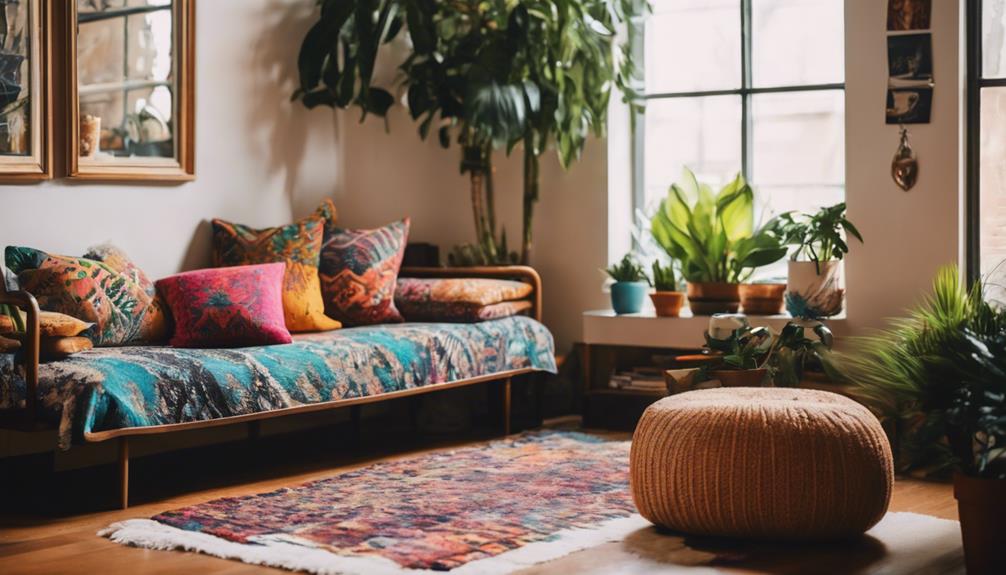
When it comes to essential fixtures and furniture for your indie room, choosing standout pieces can really elevate the vibe.
A vintage mid-century coffee table and a reclaimed wood bookshelf not only serve practical purposes but also add character.
Don't forget a vintage armchair with patterned fabric to create a cozy, inviting space that reflects your unique style.
Vintage Mid-Century Coffee Table
A vintage mid-century coffee table serves as a stunning centerpiece, effortlessly blending clean lines and organic shapes into your indie room decor. These tables, often made from a mix of wood and metal, showcase iconic design elements from the 1940s to the 1960s, like tapered legs and minimalist aesthetics. This timeless appeal perfectly complements the indie aesthetic decor, emphasizing individuality and retro charm.
When you choose a vintage mid-century coffee table, consider how its size relates to your seating arrangement. You want it to enhance the overall layout and functionality of your space. Look for these gems at thrift stores or flea markets; they offer sustainable and affordable options that add a unique personality to your room.
To elevate the table's charm, pair it with eclectic decor, such as colorful textiles and striking art pieces. This combination not only enhances the table's appeal but also integrates it seamlessly into your indie-inspired environment.
With the right vintage mid-century coffee table, you can create a cozy gathering spot that reflects your style and invites conversation, making it a true focal point in your decor.
Reclaimed Wood Bookshelf
Reclaimed wood bookshelves infuse your indie room with rustic charm while showcasing the beauty of sustainability and unique imperfections in the wood. These bookshelves serve as essential fixtures that not only provide storage for your favorite books but also create a stylish display for personal trinkets, plants, and eclectic decor items that reflect your personality.
With a variety of finishes available, reclaimed wood bookshelves blend seamlessly into both vibrant and earthy color palettes typical of indie decor. Each handcrafted piece is one-of-a-kind, aligning perfectly with the individuality celebrated in indie aesthetics. This uniqueness allows you to create a truly unique space that stands out.
Thrifting or sourcing reclaimed wood bookshelves can be a cost-effective way to add character to your room while supporting eco-friendly practices. You'll not only enhance the visual appeal of your space but also contribute to sustainability.
Vintage Armchair With Patterned Fabric
Vintage armchairs with patterned fabric become eye-catching focal points in your indie room, infusing the space with character and a rich sense of history.
These unique pieces can elevate your indie aesthetic room decor, making it feel personalized and inviting. When you choose bold patterns—whether floral or geometric—you enhance the eclectic vibe that defines indie spaces, creating visual interest.
Thrift stores and flea markets are excellent places to discover a vintage armchair that tells a story. Not only can you find affordable options, but you also align with the sustainability ethos that's integral to the indie aesthetic.
If you find a piece that needs some love, consider refurbishing it by reupholstering it with fun, colorful fabric. This way, you'll create a one-of-a-kind chair that reflects your individual style and creativity.
To truly embrace the indie vibe, incorporate your vintage armchair into a cozy reading nook. Layer it with soft textiles and warm lighting, and you'll enhance the inviting atmosphere of your space.
Ultimately, a vintage armchair is more than just furniture; it's a statement piece that adds depth and charm to your room.
Lighting Ideas
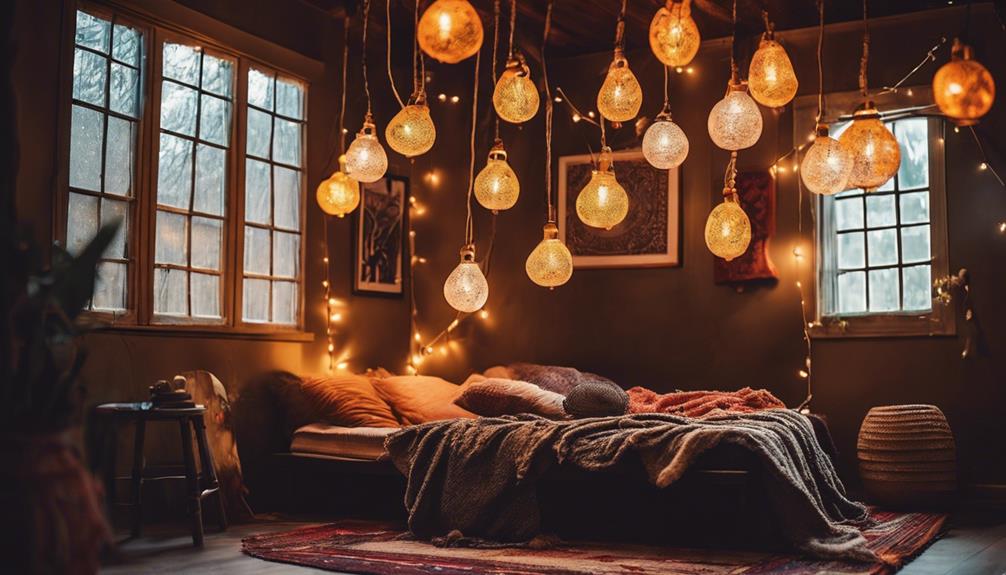
When it comes to lighting your indie room, think about incorporating vintage Edison bulb fixtures and hanging string lights for that cozy vibe.
Colorful neon wall sconces can add a fun pop of color, while mood-enhancing LED strip lights let you customize your ambiance.
These choices not only brighten your space but also reflect your unique style.
Vintage Edison Bulb Fixtures
Adding vintage Edison bulb fixtures instantly transforms your space with a warm, nostalgic glow that invites a cozy atmosphere. These unique lighting options are perfect for accentuating your indie aesthetic, making them popular decor items for any room.
With their exposed filaments, vintage Edison bulbs not only illuminate your space but also serve as striking statement pieces that enhance your overall decor. Available in various designs, like pendant lights and wall sconces, you can easily integrate these fixtures into different styles while maintaining that indie vibe.
If you're conscious about energy consumption, consider opting for LED versions of these bulbs. They offer the same classic look but use considerably less electricity, aligning with sustainable decor practices.
To take your lighting game to the next level, think about incorporating dimmer switches with your Edison bulb fixtures. This allows you to customize lighting levels based on your mood, enhancing the overall atmosphere and versatility of the space.
Hanging String Lights
Hanging string lights can elevate your indie room decor by creating a warm and inviting ambiance that complements the vintage Edison bulbs beautifully. These lights are a popular choice for adding character to your space, whether you prefer delicate fairy lights or bold globe lights. You can drape them along walls, ceilings, or furniture to create unique visual effects that enhance your overall design.
To bring in a bright and colorful touch, consider using colored string lights that add a playful pop to your wall decor. This not only ties in with the vibrant hues often found in the indie aesthetic but also allows you to express your individuality. Whether you want a cozy nook for relaxation or a lively area for social gatherings, incorporating hanging string lights as part of your layered lighting options enhances the mood perfectly.
Experiment with different arrangements to find what works best for your space. You might string them in a zigzag pattern across the ceiling or outline a favorite piece of art. Whichever way you choose to set them up, hanging string lights will surely create an inviting atmosphere that everyone will love!
Colorful Neon Wall Sconces
Colorful neon wall sconces instantly brighten up your indie room, transforming any wall into an enchanting focal point. These vibrant wall accents add a playful pop of color that perfectly aligns with the colorful indie aesthetic style. You'll find sconces in various shapes and designs, allowing you to personalize your space and reflect your unique creativity.
Neon lighting evokes a nostalgic feel, reminiscent of the 2000s pop culture that many appreciate in the modern Indie Kid aesthetic. By incorporating these sconces, you not only enhance the visual appeal of your room but also create a warm and inviting atmosphere. They work wonderfully alongside soft ambient lighting, making your space feel cozy while still being stylish.
Another great aspect of colorful neon wall sconces is that many are energy-efficient LED options. This makes them a sustainable choice for eco-conscious decorators who want to make a bold visual impact without compromising on environmental responsibility.
Mood-Enhancing LED Strip Lights
Mood-enhancing LED strip lights offer a versatile way to elevate the ambiance in your indie room, complementing the vibrant energy created by colorful neon wall sconces.
You can easily install these lights around furniture, walls, or ceilings, customizing the lighting effects to suit your different moods and activities. With their color-changing features, you can choose from a spectrum of vibrant colors that perfectly match the playful palette of the indie aesthetic.
Many LED strip lights come with remote controls or smartphone apps, allowing you to adjust brightness and colors without ever leaving your seat. This convenience lets you set the right vibe, whether you're hosting friends or enjoying a cozy night in.
Get creative by outlining shelves or framing your favorite posters with LED strips; this adds depth and visual interest to your decor.
Plus, these energy-efficient LED lights consume less power than traditional bulbs, making them a sustainable choice for enhancing your space while cutting down on electricity costs.
Incorporating mood-enhancing LED strip lights is an easy way to transform your indie room into a vibrant sanctuary that reflects your unique style.
Decorative Elements
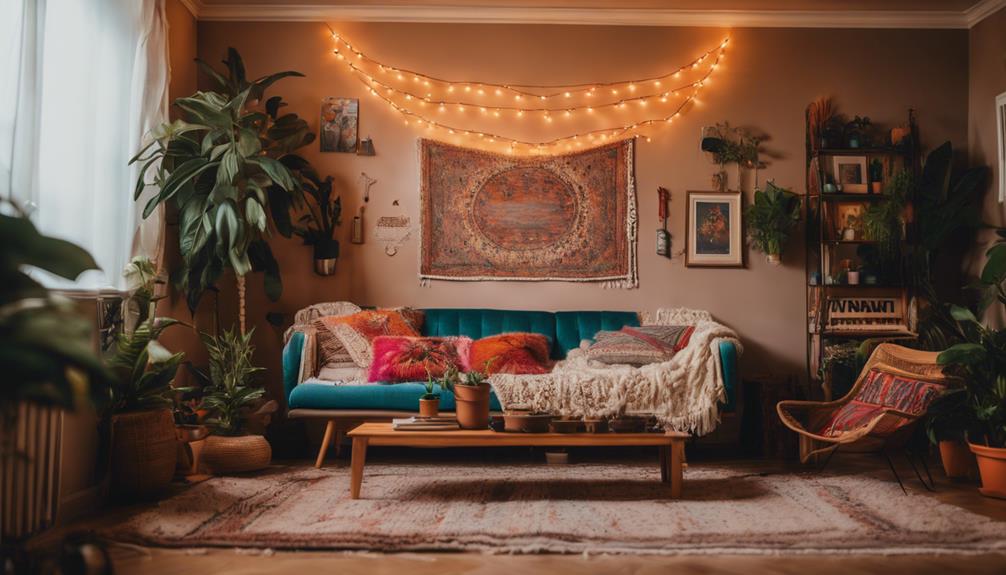
To elevate your indie room's vibe, consider incorporating decorative elements like vintage ceramic planters and framed vintage album covers.
These pieces not only add visual interest but also tell a story about your personal style.
A macrame wall hanging can tie everything together, bringing warmth and texture to your space.
Vintage Ceramic Planters
Vintage ceramic planters add a touch of artistic flair and history to your indie room decor, showcasing unique designs that spark conversation. With their colorful glazes and intricate patterns, these planters not only house your favorite plants but also serve as eye-catching statement pieces.
When you incorporate vintage ceramic planters into your space, you introduce unique textures and colors that align perfectly with indie room ideas focused on eclectic decor.
Thrifting for these planters is a fantastic way to promote sustainability, allowing you to repurpose beautiful items while making an environmentally friendly choice. Plus, by choosing vintage, you're adding character to your room that new items simply can't replicate.
Pair your planters with other retro elements, like vintage books or art, to create a cohesive theme that enhances the harmonious indie vibe you're aiming for.
Whether you place them on a windowsill or a stylish shelf, vintage ceramic planters infuse your space with personality and charm. So, don't hesitate to explore local thrift stores and flea markets—you might just discover the perfect ceramic gem to elevate your decor!
Framed Vintage Album Covers
Incorporating framed vintage album covers into your indie room can amplify the personal touch of your decor while showcasing your unique taste in music. These striking decor pieces not only add character but also serve as conversation starters that evoke nostalgia for iconic artists and bands.
To create an indie room collection that truly reflects your style, consider using mismatched vintage frames. This eclectic approach enhances the overall aesthetic, making your wall hangings a focal point in the space.
Arranging your framed vintage album covers in a gallery wall format allows for creative expression and a visually stunning display. You can mix different sizes and orientations to create an engaging layout that draws the eye.
Additionally, pairing these album covers with other decor elements, such as plants or fairy lights, can create a harmonious blend of music and ambiance in the room.
Macrame Wall Hanging
Macrame wall hangings bring a unique blend of texture and warmth to your indie room, making them a must-have decorative element.
These handcrafted pieces showcase intricate knotting techniques that enhance the indie aesthetics you're aiming for. Ranging from simple designs to complex patterns, macrame wall hangings allow you to express your individuality and creativity.
Often crafted from natural materials like cotton or jute, these pieces contribute to a cozy, bohemian vibe that fits perfectly within your space.
The versatility of macrame means you can use it not just as wall art, but also as hanging plant holders or even room dividers, adding both functionality and visual appeal to your decor.
Flooring
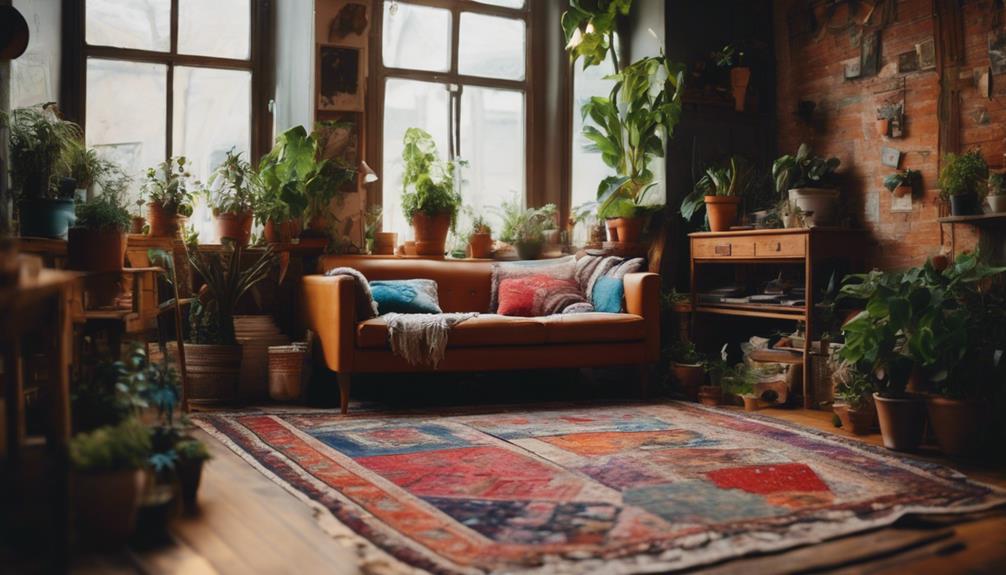
When it comes to flooring in your indie room, you've got some fantastic options to contemplate.
Reclaimed hardwood floor planks add a warm, rustic touch, while cork flooring keeps things cozy and eco-friendly.
Don't forget about a textured jute area rug to tie the space together with style and comfort.
Reclaimed Hardwood Floor Planks
Reclaimed hardwood floor planks bring a unique character and history to your indie-inspired space, making them a perfect choice for adding warmth and rustic charm. Sourced from old barns, factories, and other buildings, each plank has its own story, enhancing the aesthetic appeal of your room. The natural imperfections and variations in color and grain of reclaimed hardwood create an inviting atmosphere that feels both homey and stylish.
Opting for reclaimed hardwood also means you're choosing sustainable materials. By repurposing existing wood, you help reduce the demand for new lumber, which is essential for protecting our forests. This eco-friendly choice not only benefits the environment but can also increase your home's value, attracting buyers who appreciate unique and responsible design.
When it comes to maintenance, you'll find that reclaimed hardwood floors are durable and relatively easy to care for. Regular cleaning and occasional refinishing keep them looking their best, allowing you to enjoy the rustic charm they bring to your indie room for years to come.
Embrace the character and warmth of reclaimed hardwood flooring, and watch your space transform into a cozy haven everyone will love.
Cork Flooring for Warmth
Cork flooring offers an inviting warmth and comfort, making it a superb choice for achieving that cozy indie aesthetic in your room. Its natural insulation properties help maintain a comfortable temperature, which can be particularly beneficial in varying climates. You'll appreciate how cork flooring keeps your space cozy without driving up energy costs.
The unique texture of cork flooring adds a distinctive touch to your decor while promoting a natural, earthy vibe that aligns perfectly with indie aesthetic principles. This material stands out not just for its look but also for its feel underfoot, enhancing the overall comfort of your space.
Moreover, cork is a sustainable material, harvested from the bark of cork oak trees without harming the trees themselves. Choosing cork flooring means you're making an eco-friendly decision that benefits both your home and the environment.
Plus, it's resilient and resistant to mold and mildew, ensuring durability and low maintenance for your stylish indie room designs. With cork flooring, you're not just adding warmth; you're creating a unique, inviting atmosphere that everyone will love.
Textured Jute Area Rug
A textured jute area rug complements the warmth of cork flooring while adding an organic touch that enhances the cozy indie aesthetic of your space. Jute is an eco-friendly material, making it a sustainable choice that aligns perfectly with your commitment to individuality and unique design. The neutral tones of a jute rug work wonderfully with vibrant colors and eclectic decor, creating a versatile backdrop that ties your room together.
Not only does a textured jute area rug provide visual interest, but it also helps define spaces in open floor plans, giving your home a more intentional layout. You can choose from various sizes and patterns, allowing for personalized styling that reflects your taste and personality.
Whether you prefer a simple design or something more intricate, a textured jute rug can serve as the anchor for your indie room, balancing comfort and style seamlessly.
Conclusion
Creating an indie room is all about personal expression and unique touches. By focusing on key elements like essential fixtures, cozy lighting, and eye-catching decor, you can transform any space into a haven that reflects your style.
Don't forget about flooring—it can tie everything together! Embrace your creativity, mix and match different styles, and you'll end up with a space everyone will love.
So, go ahead and start designing your dream indie room today!
